Decoloration Mechanism of Double Doped Zinc Tungstate
The modification of zinc tungstate by doping rare earth elements is an effective way to improve its luminescent properties.
The single crystal of zinc tungstate is rose red, the color makes the luminous efficiency decrease and the decoloration effect is obvious.
After annealing for a long time, the ZnWo4 crystal will disappear gradually, but the annealing of the bulk crystal still has difficulties which can not be overcome. The main problem is that the defect is incomplete and the defects are introduced into the annealing process.

In single doped rare earth crystals, only cerium doped Ce3+ can recede the color of the crystal, both doped cerium Ce3+ and lithium li3+ have obvious decoloration effect on zinc tungstate crystal, especially, the former can obtain colorless crystal by proper doping.
The removal mechanism of zinc tungstate may be due to the decomposition of CO2 in Li2CO3 crystals, CO2 molecules will be partially retained in the lattice, CO2 molecules and O2 molecules are linear molecules, and the radius of the two has little difference, can replace each other in the hole. Therefore, when the crystal grows, the CO2 molecules fill in the oxygen vacancies to make the crystal clear.
Through the mechanism of doped zinc tungstate, it can be seen that the segregation coefficient of Ce3+ and Sm3+ in ZnWo4 crystal increases after double doping, it is beneficial to obtain high content of crystals, thereby changing the short life of fluorescence and the quenching temperature of luminescence is too low.
If you have any inquiry of tungsten, please feel free to contact us:
Tel.: +86 592 5129696/+86 592 5129595
Fax: +86 592 5129797
Scan QR code of Chinatungsten Wechat platform to follow up the daily latest price and market of tungsten, molybdenum and rare earth.




评论
发表评论